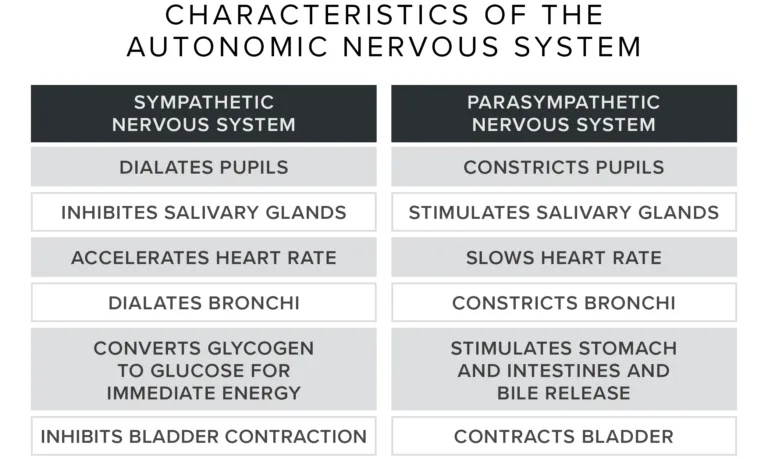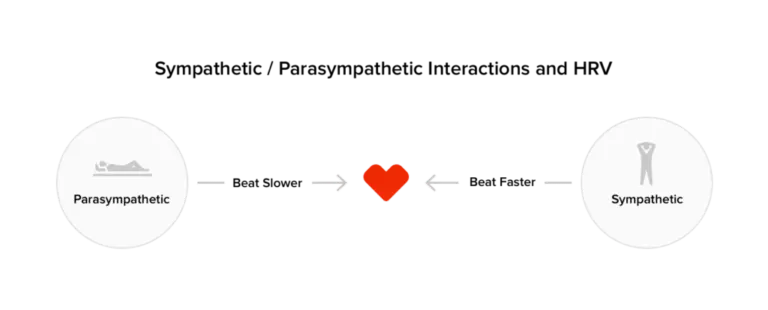Topics
- Article
- HRV
Sympathetic vs. Parasympathetic Nervous Systems: How They Work

The sympathetic and parasympathetic nervous systems regulate heart rate, blood pressure, temperature, digestion and other functions, allowing us to adjust these activities without conscious thought.
The autonomic nervous system (ANS) is also called the involuntary nervous system. It regulates important bodily functions such as heart rate, blood pressure, sweating, temperature, pupil dilation, and digestion. The system allows us to react and adjust these functions without consciously thinking about them. The ANS is further divided into two components: The sympathetic and parasympathetic nervous systems. These two systems work in conjunction to provide input to your body at all times, acting to decrease or increase activities. In a healthy system, when it’s time to act or there is a perceived threat, the sympathetic will dominate, when there are no threats, the parasympathetic dominates.
Sympathetic Nervous System: Fight or Flight
The ANS directs your body’s rapid and involuntary response to strain, such as danger, disease, and exercise. It sends messages to organs, muscles, and glands to increase heart rate, dilate the bronchial tubes to your lungs, increase perspiration, and cause pupil dilation. This “fight or flight” response is an evolutionary survival mechanism, enabling humans and other mammals to react quickly to life-threatening situations such as an oncoming car or a buffalo speeding towards them. But your body may also react during non-life threatening stress too, like traffic jams, making a presentation at work, or family arguments. While your body is busy responding to stressors, the SNS inhibits non-vital functions such as digestion and salivation to stop energy from going to those organs and focus it on saving your life or nailing that presentation. The SNS does not calm you down after it’s wound you up though, that role is performed by the parasympathetic system.
Parasympathetic Nervous System: Rest and Digest
The parasympathetic nervous system (PSNS) works in opposition to the sympathetic system, controlling the body’s ability to relax. It mainly functions to downregulate the body using the vagus nerve, which sends impulses from the brain to the body and back. The PSNS works to tell your brain what’s happening within your body, instead of your brain telling your body what to do. It usually activates when you are feeling relaxed or in a mundane situation. The PSNS slows your heart and respiratory rates, narrows pupils, and increases digestion. It’s called the “rest and digest” or “feed and breed” system as it conserves the body’s natural activities until after a stressful situation has passed. Once the danger is over, the PSNS returns the body to homeostasis.

The sympathetic and parasympathetic systems are parts of the autonomic nervous system and have opposing Effects on several systems.
Autonomic Nervous System and Heart Rate Variability
Heart rate variability (HRV) is a measure of how the SNS and PSNS affect your heart beat. When your nervous system is balanced, your heart is constantly being told to beat slower by your parasympathetic system, and to beat faster by your sympathetic system. These mixed messages result in a constant state of variation in your heart rate. HRV is the variance in time between beats. For example, if your heart beat is 60 bpm, the time between beats is likely not exactly 1 second. It may be 0.9 seconds between two beats and 1.1 seconds between two others. When you have high heart rate variability, it means that your body is responsive to input from both the SNS and PSNS. This is a sign that your nervous system is balanced, and that your body is capable of performing at its best. Conversely, a low HRV means that one branch is dominating and sending stronger signals to your heart than the other. This may occur during a race for example, when the SNS is focused on allocating resources to your legs (sympathetic activity) as opposed to digesting food (parasympathetic activity). But it may also occur when you’re tired or sick, leaving fewer resources available for tasks like exercising or giving a work presentation. Essentially, if one system is dominating, it means the SNS has less ability to take over when it needs to, such as when you’re facing down a bear.

HRV is a result of the sympathetic and parasympathetic nervous systems affecting your heart beat from second to second.
WHOOP Calculates HRV to Help Monitor Your ANS
WHOOP monitors your heart rate and calculates your HRV on a nightly basis using a dynamic average during sleep. It is weighted towards your last stage of slow wave sleep when you’re in your deepest period of sleep and your body is most at rest. An accurate understanding of your baseline HRV enables you to monitor how your parasympathetic and sympathetic nervous systems are performing. You can view your daily HRV in the WHOOP app and track it over time using the Health Monitor.